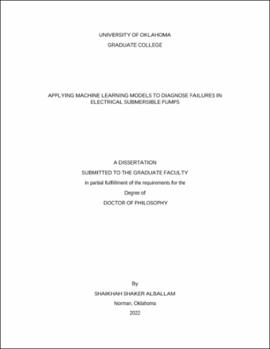| dc.contributor.advisor | Karami, Hamidreza | |
| dc.contributor.author | AlBallam, Shaikha | |
| dc.date.accessioned | 2022-12-08T21:09:55Z | |
| dc.date.available | 2022-12-08T21:09:55Z | |
| dc.date.issued | 2022-12-17 | |
| dc.identifier.uri | https://hdl.handle.net/11244/336890 | |
| dc.description.abstract | Electrical Submersible Pump (ESP) failures are unanticipated but common occurrences in oil and gas wells. It is necessary to detect the onset of failures early and prevent excessive downtime. This study proposes a novel approach utilizing multi-class classification machine learning models to predict various ESP specific failure modes (SFM’s). A comprehensive dataset and various machine learning algorithms are utilized. The prediction periods of 3 hours to 7 days before the failure are evaluated to minimize false alarms and predict the true events.
The ML models are based on field data gathered from surface and downhole ESP monitoring equipment over five years of production of 10 wells. The dataset includes the failure cause, duration of downtime, the corresponding high-frequency pump data, and well production data. According to these data, most ESP operational failures are characterized as electrical failures.
Four modeling designs are used to handle the data and transform them into actionable information to predict various ESP failure modes at different prediction periods. Several ML models are tested and evaluated using precision, recall, and F1-score performance measures. The K-Nearest Neighbor (KNN) model outperforms the other algorithms in forecasting ESP failures. Some other tested models are Random Forest (RF), Decision Tree (DT), Multilayer Perceptron (MLP) Neural Network, etc. The findings of these ML models reveal that as the prediction period extends beyond three days, it becomes more challenging to predict the true failures. Furthermore, all tested designs show similarly good performances in predicting ESP specific failures. The design that integrates the impacts of gas presence and pump efficiency while minimizing the number of input variables is suggested for general use.
Based on the field data, a Weibull model is built to estimate the probability of failure. The mean time between failure (MTBF) values are utilized as inputs to the Weibull analysis. The Weibull shape and scale parameters are estimated using Median Rank Regression. Then the Weibull Probability plots are generated with high R2 values (86.5-99.4%) and a low p-value for all wells. The results show increases in pump unreliability with time for all the wells.
By integrating the outcomes of the ESP Failure prediction ML model with the Weibull unreliability model, a powerful tool is provided. This tool allows the engineers to detect failures early, diagnose potential causes, and propose preventive actions. It is crucial in aiding the operators in transitioning from reactive to proactive and predictive maintenance of artificial lift operations. | en_US |
| dc.language | en_US | en_US |
| dc.rights | Attribution-NonCommercial-NoDerivatives 4.0 International | * |
| dc.rights.uri | https://creativecommons.org/licenses/by-nc-nd/4.0/ | * |
| dc.subject | ELECTRICAL SUBMERSIBLE PUMPS | en_US |
| dc.subject | Petroleum Engineering | en_US |
| dc.subject | Data Analytics | en_US |
| dc.title | Applying machine learning models to diagnose failures in electrical submersible pumps | en_US |
| dc.contributor.committeeMember | Devegowda, Deepak | |
| dc.contributor.committeeMember | Nicholson, Charles | |
| dc.contributor.committeeMember | Wu, Xingru | |
| dc.contributor.committeeMember | Pereyra, Eduardo | |
| dc.date.manuscript | 2022-12-06 | |
| dc.thesis.degree | Ph.D. | en_US |
| ou.group | Mewbourne College of Earth and Energy::Mewbourne School of Petroleum and Geological Engineering | en_US |
| shareok.orcid | 0000-0002-5998-3107 | en_US |
| shareok.nativefileaccess | restricted | en_US |

